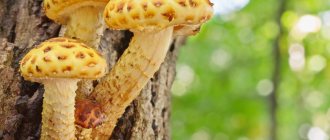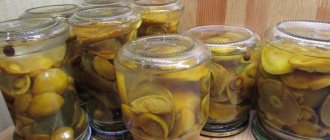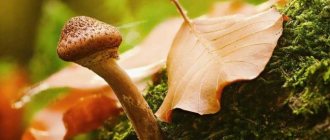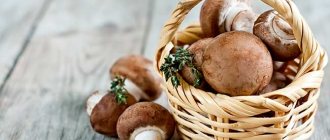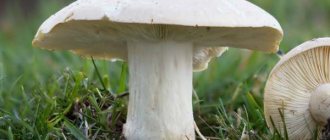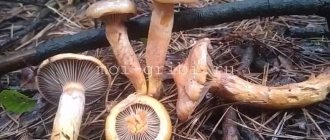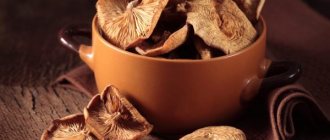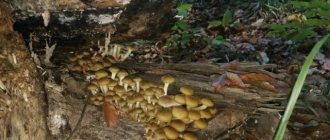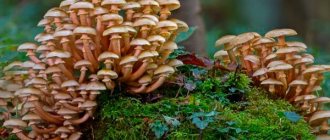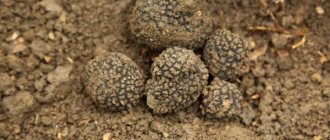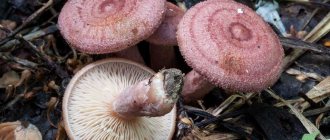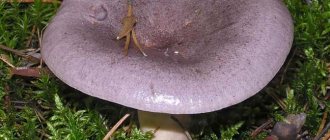Surely many of us have come across these interesting and “cute” mushrooms at least once in our lives. “Silent hunting” for honey mushrooms is always very exciting and useful, because along with pleasant relaxation in the fresh air, you can collect a whole basket of edible fruiting bodies. Moreover, this can be done in just one small area, so to speak, “without leaving the cash register.” The fact is that honey mushrooms always grow in friendly families, so such a find is a real joy in harvesting mushrooms.
Where do autumn royal mushrooms grow?
It is worth noting that edible species of royal honey mushrooms grow on damaged tree trunks and old, long-cut stumps.
They can also be found on the ground next to the roots of dead deciduous and coniferous trees. Fruiting of golden scales or royal honey mushrooms begins in August and continues until the end of September. Residents of the Primorsky Territory can collect these amazing mushrooms from mid-May to mid-September. Where else do royal honey mushrooms grow, and which trees are preferred most? Typically, this species of honey mushrooms settles on the trunks of deciduous trees, especially alder or willow; sometimes it chooses birch trees and birch stumps, less often – coniferous trees in wetlands. Look at the photos below showing what royal honey mushrooms look like on trees in the forest:
Sometimes even experienced mushroom pickers, due to the rare appearance of golden scales, confuse them with false honey mushrooms, which grow in the same areas. Therefore, we suggest that you carefully read the photos of edible and false royal honey mushrooms:
As mentioned, scale mushrooms or king mushrooms are edible mushrooms. However, before using it, it must be boiled in salted water for 20-25 minutes. Since royal honey mushrooms have excellent taste, they are used in appetizers, salads, first and second courses. The flakes go especially well with fried or boiled potatoes. In addition, many housewives make preparations for the winter from these mushrooms: pickled, salted, frozen and dried.
Sometimes honey mushrooms can be found in pine forests and spruce forests. What does the royal honey fungus look like if you find it in a coniferous forest? Typically, scales collected in deciduous forests differ from those growing in coniferous forests. The first difference between honey mushrooms found in pine forests is the dark color of the cap and scales, and the second is the bitter taste. However, royal honey mushrooms contain a lot of vitamin C, PP and E. In addition, there are only 22 calories per 100 g of flakes, so the calorie content of this species is very low. That is why they are useful for vegetarians and those who follow a low-calorie diet. In terms of phosphorus and calcium content, royal honey mushrooms even compete with fish.
Experts have classified royal honey mushrooms as category IV of edibility. That is why in other countries they are not eaten or even collected, since this category abroad refers to inedible species. However, in Russia they are prepared in the same way as ordinary autumn mushrooms. They are first boiled in salted water and only then fried, stewed or cooked as first courses. In addition, royal autumn honey mushrooms are used in other culinary recipes: they prepare mushroom stew, julienne, make caviar, pates, sauces, solyankas and mushroom fillings for pizzas and pies.
Although golden flake is widespread in Russia and is well recognized, it is not collected so often. This may be due to the fact that this type of mushroom is not familiar to many people. However, real connoisseurs of mushroom delicacies put it on a par with autumn honey mushrooms and even boletus mushrooms. We invite you to watch a video of royal honey mushrooms being collected in deciduous forests by lovers of “silent hunting”:
Are overgrown honey mushrooms dangerous for adults?
This question is asked by almost all mushroom pickers who come across mature honey mushrooms. After all, it is known that all types of fruiting bodies, without exception, absorb radiation and heavy metal salts. And the older the mushroom, the more harmful substances it has absorbed from the air. Are overgrown mushrooms dangerous in this case?
It must be said that it is quite rare to find an overgrown honey fungus that will have quality indicators. The state of the fruiting body can be seen from its appearance. As a rule, overgrown honey mushrooms change for the worse over time. The structure of its body is destroyed, and as a result the mushroom becomes flabby and loose. The hats dry out and then cracks appear on them. In this regard, the rigidity of the pulp of the fruiting bodies increases significantly. The features of adult honey mushrooms are shown in more detail in the photo below:
In addition, among mature mushrooms you can often find moldy and wormy specimens. In some cases, there is even an unpleasant odor. If you notice any mold or blackness covering even the smallest part of the surface of the mushroom, then you should refuse to collect them. In the same way, if the mushroom is damaged, loose, rotten, or it simply gives you the slightest doubt, do not hesitate to pass by. After all, such external indicators clearly indicate the worminess of the fruiting body. And the unaesthetic appearance itself is unlikely to whet your appetite.
However, even among overgrown honey mushrooms, you can find whole, strong, juicy and quite attractive “burdocks”, which are practically no different from their younger representatives. In this case, there is no reason not to take the mushroom into your basket. Most likely, worms will be present in this fruiting body, but this feature can be easily corrected.
As already mentioned, mushrooms, like “sponges,” absorb harmful substances from the atmosphere, so it is strictly forbidden to collect them near highways, factories and other enterprises. Otherwise, you risk your health, because the concentration of heavy metal salts in such fruiting bodies can be critical. It must be said that this rule applies not only to overgrown honey mushrooms, but also to young ones.
Emergency care for mushroom poisoning
- Gastric lavage. At home, you should drink water and induce vomiting by pressing on the root of the tongue. In a hospital, this procedure is carried out using a probe.
- Cleansing enema. It is given if more than two hours have passed since the poisoning.
- Reception of adsorbents. Activated carbon, Enterosgel and other drugs will help bind toxins and neutralize them.
- Drinking salted water or drugs whose action is aimed at combating dehydration. Drink water in small sips, often. The drugs are taken according to the instructions. When the vomiting stops, the patient can be given strong, sweet tea.
- Wrapping up. The victim must be warmed up. Hypothermia may occur due to severe dehydration. Warm blankets, heating pads and complete rest are the first things to do when vomiting and diarrhea stop.
Preparing Ingredients
If these mushrooms are collected in clear and warm weather, then for their subsequent drying you can get by with dry cleaning using a soft cloth, which removes forest debris in the form of grass and small leaves from the mushrooms. This method of cleaning before drying is preferable, since washing in water worsens the taste of honey mushrooms and lengthens their drying time.
If they are intended to be used for salting, pickling, fried or for cooking, they must be washed three times in water. This operation makes it easier to remove rings from mushroom stems, which worsen the taste of the boiled or pickled product, giving it acidity and an undesirable odor.
Did you know? The kingdom of fungi, combining the characteristics of both animals and plants, is extremely extensive. For example, for every type of vegetation existing on the planet there are 6 mushrooms. In total, there are up to 2 million species of mushrooms in the world, of which only 100 thousand have been studied.
Recipes for golden flake dishes
Before preparing the main course, royal honey mushrooms require preliminary cooking. The stems are cut off almost completely, then the mushrooms are soaked for at least 20 minutes to completely remove debris and insects that have gotten into the plates. Then they are boiled in salted water and placed in a colander to drain excess moisture. It is believed that when pre-cooking, it is necessary to put an onion in the pan: if it darkens, then poisonous honey fungus has become “stuck” among the mushrooms. Unfortunately, it is impossible to identify a poisonous individual in this way. Golden flake recipes:
- Pickled honey mushrooms
. The prepared mushrooms are boiled 2 more times for 20 minutes, each time rinsing with running water and adding new water. The jars are sterilized along with the lids, and at this time the marinade is boiled. Proportions: 1 kg of mushrooms, clean water - 600 ml, salt - 2 tablespoons, the same amount of sugar, 12 black peppercorns, 5 bay leaves and 9% vinegar - 2 tablespoons. Boil the marinade for 5 minutes, add 3-4 crushed large cloves of garlic, boil for another 2 minutes. Transfer the mushrooms into jars, pour boiling marinade over them and screw on the lids. The preserved food is left to cool upside down, under a blanket. - Golden flake in sour cream
. Place 1 kg of pre-prepared mushrooms in a colander or paper towels to remove remaining moisture, cut a large onion into rings and fry it in vegetable oil until golden brown. Lay out the mushrooms, fry for 15 minutes, pour half a glass of fatty, preferably country, sour cream into the frying pan, and simmer for 30 minutes. Then sprinkle the roast with chopped herbs - dill and parsley, close the lid and let the dish brew for at least 15 minutes. Serve with fried or boiled potatoes. - Chicken soup with honey mushrooms
. Honey mushrooms are prepared in the usual way, boiling for at least 20 minutes. Finely chop the onions and carrots - it is more convenient to use a blender, since grating the onions will sting your eyes too much. Potatoes are cut into small cubes. It is advisable to finely chop and boil the chicken meat: place the chicken in boiling water, add a whole onion to the container, and boil for 15 minutes. At this time, fry the onion-carrot mixture in a frying pan with sunflower oil, add mushrooms and also fry for 15 minutes. Remove the onion from the chicken broth, add potatoes, fry completely and cook until done. To improve the taste, use bay leaf, black and allspice peppers, and salt. It is better to sprinkle the soup already poured into bowls with herbs. - Royal honey mushrooms in a slow cooker
. In a modern multi-cooker pan, you can pre-cook royal honey mushrooms and prepare the main dish. Place the washed mushrooms in a bowl, set to stew for 30 minutes, and then place on a steamer. While the liquid is draining, chop the onions and carrots. Heat the bowl on the “fry” mode and pour all the ingredients into it together. You can try the dish after 40 minutes - salt, pepper and add herbs to taste. - Salad with golden flakes
. Boiled chicken fillet is marinated in soy sauce. Boil the potatoes, cut into cubes, cut the carrots. The pickled mushrooms are washed and cut into equal pieces. Mix potato cubes with carrots, mushrooms and fillet pieces. A large onion is cut into rings, each ring is rolled in flour, fried until golden brown, the parsley is washed and torn by hand. The salad is decorated with fried onion rings and parsley sprigs. - Diet puree soup
. The potatoes are cut, boiled until half cooked, the onions and carrots are sautéed in a frying pan with a minimum amount of sunflower oil. Pre-prepared honey mushrooms are fried together with onions and carrots for 20-25 minutes under a lid. The potatoes are taken out of the water - the broth is not poured out, they are combined with the frying, and crushed with a blender. Bring the water to a boil, add the ground mass into it, mix well and leave to infuse under the lid, pouring in half a glass of heavy cream. Salt to taste, add herbs to each plate.
Golden flakes can be used to prepare filling for pies or add to casseroles. Mushrooms are prepared for the winter not only by pickling, but also by freezing. Pre-treatment of thawed mushrooms is carried out in the same way as fresh ones.
How to defrost mushrooms?
Proper thawing can affect the quality and consistency of the dish. It should occur gradually at room temperature. It is not advisable to place mushrooms in the oven or microwave for this purpose.
Raw honey mushrooms should be completely defrosted and dried, and then cooked. You can put frozen fruits in soups. If honey mushrooms are going to be marinated in the future, they need to be boiled for 10 minutes and then boiled in the marinade.
If boiled mushrooms are placed in the freezer, they must first be thawed and only then used in cooking. Fried mushrooms also need to be defrosted and only then heated in a frying pan.
If you are thinking about how to freeze honey mushrooms at home, decide what dishes you are going to cook with them in the future. The method of freezing and storage will depend on this. Consider the volume of the freezer: this will allow you to prepare more forest products. If you do everything correctly, delicious mushrooms on the New Year's table will definitely delight you and your guests.
You can enjoy delicious freshly picked forest mushrooms only for a few months a year, because the mushroom season usually comes in the fall. However, it is not at all necessary to refuse such goodies in other months. If previously, preparing honey mushrooms for the winter consisted exclusively of making pickles, then recently products frozen in the freezer have become much more popular. Recipes for freezing honey mushrooms for the winter are so diverse that every housewife will certainly be able to find her ideal option among them.
The main feature of honey mushrooms is that they do not grow alone, so you can quickly collect a full basket in the forest. Experienced mushroom pickers do not recommend drying these mushrooms, because this causes them to lose their exceptional taste. However, frozen mushrooms, when properly prepared, will be no worse than freshly picked products. Moreover, they completely retain their taste, aroma and numerous beneficial properties. Mushrooms contain zinc, copper, proteins, glycogen and other minerals. To properly prepare frozen mushrooms, you should use the advice of experienced mushroom pickers:
Mushrooms that have just been picked should be canned or frozen. If honey mushrooms stand in the refrigerator for several days, they will be completely unsuitable for freezing or pickling. Mushrooms should be processed as soon as possible within the first 24 hours after collection. It is worth noting that the type of food processing depends entirely on the exact form in which you plan to store honey mushrooms for the winter. Only first-class mushrooms without wormholes or serious physical damage are suitable for freezing and canning. It is best to give preference to young mushrooms. It is better to immediately sort fresh mushrooms by size.
If you really love the exceptional mushroom aroma of honey mushrooms and their dense structure, it is better to freeze such products fresh for the winter. It is worth noting that all wild mushrooms that have a sponge under the cap are recommended to be harvested raw. However, each housewife chooses the processing method at her own discretion.
It is strictly forbidden to wash mushrooms that you plan to freeze freshly picked. You just need to remove all large debris and smaller specks from them. If the mushrooms absorb excess moisture, after defrosting their taste will be irrevocably spoiled. There is no need to cut them into pieces either. Only do this if the wild mushrooms are too large. Freeze them according to these step-by-step instructions:
- Freezing honey mushrooms at home usually involves using large flat trays. The processed mushrooms are evenly distributed over their surface and then placed in the freezer for the whole day. Don't forget to set the temperature to maximum before doing this.
- After approximately twelve hours, the honey mushrooms can be removed from the freezer. As soon as possible, distribute them into prepared containers or regular plastic bags. The temperature in the freezer can now be returned to standard levels. Dishes made from such frozen mushrooms will practically not differ in taste from delicacies with freshly picked honey mushrooms.
SCALE OR PHOLIOTA SQUARROSA
This is one of the most common foliots in the genus, otherwise they are called dry, scaly, fleecy. They grow mainly on wood.
SCALE OR PHOLIOTA SQUARROSA
The veil, which we are accustomed to seeing on the folio of this species, is characteristic mainly of newly grown specimens, which later forms a distinctive skirt on their stem and looks like fleecy scales on the edge of the cap.
External description: sometimes mature mushrooms reach a cap diameter of 20 cm, but for the most part the diameter of this representative is 5–12 cm. Mature mushrooms have a hemispherical or conical cap, then it becomes flat-convex or protruding (highly convex) in shape. The slimy surface has bright yellow dry scales. They taste bitter, but are edible. When broken, the pulp has a whitish or yellowish color.
Preparation of dried mushrooms
Honey mushrooms, due to their dense structure, are often harvested in winter by drying. Dried, they hold their shape well and retain their aroma. Before drying, raw mushrooms are cleaned of debris, soil and dark spots on the stems or cap, and then subjected to the drying process.
In order to prepare something from dried honey mushrooms, they must first be soaked in water for 4-12 hours so that the mushrooms are saturated with moisture and return to their original shape. After this, cook the mushrooms according to the principle of cooking a fresh product: in two waters for a total of 30-35 minutes.
Pickled mushrooms have an amazing taste and will be an excellent snack in the winter; dense small mushrooms that do not contain flaws are selected for pickling. Large overgrown mushrooms can be used to make caviar. But whatever the preparation, honey mushrooms must be pre-cooked.
Greetings, my wonderful cooks. Tell me, how often do you pamper your household with mushroom dishes? If it is very rare, then this can be easily corrected. I decided to devote today’s article to honey mushrooms. When pickled, these mushrooms have a low calorie content - only 15.7 kcal. Therefore, today I will share what to cook with pickled honey mushrooms.
Types of flakes
The genus of scales has about 150 species, of which about 30 grow in the forests of Russia. The most common types are foliots: ordinary, golden, fiery, cinder, alder, gum-bearing, destructive, edible (hint).
Common scalyfoot
This is the most common type. Mushrooms of this type are also called fleecy, scaly, dry. They grow in colonies on the wood of living and rotten deciduous trees. The caps have a diameter of 6-10 cm; in young ones they are hemispherical in shape, in mature ones they are flat. The surface of the caps is pale yellow with pronounced orange-brown scales.
The leg is cylindrical, dense, rusty in color. Young specimens have a veil that breaks when ripe, forming a ring on their stem and flakes along the edges of the cap.
The pulp of this species is fleshy, white or yellow in color, although edible, it tastes bitter.
Golden scale (royal honey mushrooms)
The golden species is one of the largest representatives of foliots: the diameter of the cap can reach 18 cm. Their fruiting bodies are painted in a bright yellow, golden color. The surface of the cap is covered with mucus and small dark brown scales. In young specimens, the cap has a hemispherical shape with tucked edges; in adulthood, it has a saucer shape with a convex center.
Fire scale
This is an inedible species of foliot. Mushrooms of this species are smaller in size than ordinary or golden ones: the diameter of the caps does not exceed 7 cm. The caps are painted in reddish tones and covered with thick curled scales of a lighter color than the cap. The scales on the cap form a pattern of ovals. The pulp is fleshy, hard, yellow in color, becomes brown when broken, has an astringent bitter taste and an unpleasant odor, so it is not eaten. They bear fruit from mid-July to the end of September.
Cinder flake
Cinder flake is also called coal-loving. The caps of this species of mushrooms are often stained with soot and dirt, since their favorite places to grow are burnt trees and fireplaces. Soot, dust and dirt stick to the mucous surface of the caps, so the mushrooms quickly become dirty yellow or dirty brown. In young foliots, the caps are covered with a private veil; in mature ones, the remains of this veil are preserved in the form of a ring on the stem and along the edges of the cap. The legs are covered with small reddish scales. The pulp of these foliots is dense, hard, light yellow, and has no specific taste or smell. There is no information in the literature about the edibility of these mushrooms. They grow from August to October.
Alder scale
These foliots are also called alder moth. They are often found on stumps and alder or birch wood. The size of the firefly caps is small: does not exceed 5-6 cm. The color of the caps is yellow-orange, along their edge there are flake-like remains of a private blanket. The legs are curved and have a pronounced ring. Below the rings are fibrous, above the rings are smooth.
The pulp of the mushrooms is yellowish, dirty yellow, inedible. If eaten, moths can cause poisoning. They bear fruit in August-September.
Gum scale
These mushrooms are also called yellow-green because their fruiting bodies, covered with scales, range in color from light yellow to yellow-green. The diameter of the caps of gum-bearing foliots is 3-6 cm. The pulp is edible because it does not have the rare taste and smell specific to flakes.
Destroying scale
These mushrooms are often found on old and dry poplars, so their second name is foliota poplar or poplar. These fungi actively destroy the wood of the tree during their growth. The caps can reach 20 cm, are colored light brown or yellowish, and covered with white scales. The legs are thinned towards the apex and have swellings at the base. The legs match the caps in color and are also covered with scales.
Edible scale
This type of foliot is industrial. Mushrooms of this species are cultivated on a large scale in Japan and China. Their second name is foliota or nameko honey fungus. Grown in rooms with high humidity - 90-95%. They grow in groups. The sizes of these mushrooms are small - no more than 2 cm in diameter. The color of the fruiting bodies is orange-brown, the surface is covered with thick, dense jelly-like mucus.
They have soft flesh, similar in taste and smell to real honey mushrooms. On the shelves of our stores you can often find pickled edible flakes made in China. Only the inscription on the jar says that it is honey mushrooms (the second name for edible scales). Pickled foliots differ from real honey mushrooms by their mucous marinade, which is due to the jelly-like coating of the caps of the latter.
How to distinguish honey mushrooms from false ones? False and edible honey mushrooms: photos and key features
Mushroom picking is a fascinating and useful activity in every sense, but quite difficult. After all, some representatives of this kingdom have dangerous poisonous counterparts, which not everyone can recognize.
In particular, it is important to know how to distinguish edible mushrooms from false ones: the main signs characteristic of each species, as well as subtleties and tricks, after which you will definitely not pick and eat the wrong mushroom.
How to distinguish edible honey mushrooms from false ones?
Initially, it is worth understanding what the correct honey mushroom looks like and what features are characteristic of it. After this, it is already possible to examine groups of false mushrooms, isolating their key differences from the edible species, since they have many poisonous counterparts.
Gallery: varieties of flakes (47 photos)
Edible scale
Phol.nameko is a variety also known as Honey mushroom nameko, which is translated into Russian as “slippery mushroom.” It grows similarly to honey mushrooms, in whole “families”. From a single base, several fairly thin legs are formed at once.
The edible variety prefers stumps and fallen tree trunks of such not very common broad-leaved species as beech and hornbeam. The cap part is small in size, orange-brown in color, covered with slippery and jelly-like skin. It is cultivated under artificial conditions in Japan and China, where it is widely used to prepare the popular and healthy miso soup.
Edible scale
Common scalyfoot
Phol.squarrosa is a widespread parasitic edible species in our country or a classic saprotroph that develops fruiting bodies on living and dead deciduous wood. It has a flat-convex, convex-conical or hemispherical cap part with folded edges and remnants of a cover. The skin is distinguished by the presence of dry bright yellow scales, mucous type, yellow-red-orange coloring.
The soft part is light beige-yellow or greenish, with an unexpressed earthy aroma and rare taste. The plates are of an adherent type, with a frequent arrangement, yellowish or rusty-brown in color. The leg is whitish with a reddish-reddish-brown tint and the presence of a fibrous and drooping ring. The spores are rusty-reddish-brown.
Common scalyfoot
Hairy scale
Pholiota squarros is an edible variety, distinguished by a yellow or yellowish-red-brown cap with a mass of reddish-brown scales, bell-shaped or semi-prostrate in shape, with the cap edges tucked inward. The soft part is yellowish in color, bitterish, with the taste of garden radish and a pungent odor.
The plates are light yellowish or grayish-brown, growing to the stem or slightly descending. The spores are rusty-red-brown or brown. The leg is monochromatic with a cap, with a ring, covered with scales. It bears fruit from mid-August until late autumn, forming numerous fruiting bodies on stumps and on the trunk of trees.
Hairy scale
Golden scale
Phol.aurivella is a species also known as golden-yellow or grey-yellow scale, willow or royal honey fungus. It has a very characteristic bright golden yellow or golden coloring of the entire fruiting body. The edible species has a large and spherical cap with a glossy surface and the presence of rare brownish scales. Most often, single fruiting bodies are formed on alder or birch stumps in damp and swampy areas.
Golden scale
Poplar scale
Рholiota destruens is a variety also known as poplar. It is distinguished by a hemispherical and fleshy, light brown cap, covered with numerous, but not too large, white scales, reminiscent in appearance of poplar fluff. The husk on the cap is yellowish-brown in color, and the brim has hanging whitish leathery flaps.
Also read: Mushrooms of Belarus: edible, poisonous and spring species
The soft part is whitish, slightly bitter, with a characteristic malt aroma. The plates are often located, fused with the peduncle area, and are whitish, brownish or tobacco brown in color. The spores are yellow or orange. The stalk region is short and thick, thickened and rooted at the base, with a whitish or light brown surface covered with fibrils and having a vanishing ring.
Poplar scale
Fire scale
Phol.flammans is an inedible variety characterized by a bitter taste of the pulp and a not very expressive odor. It has a hemispherical or conical, then convex and flat-convex cap with distinctly folded edges and non-falling remains of the bedspread at the edges. The surface coating is dry, with very visible bright yellow scales.
The soft part is yellowish-orange or brownish in color, with a weak earthy odor, a bland taste and a faint bitter aftertaste. The plates are narrowly incremental, with a frequent arrangement, grayish-yellowish or brownish in color. The leg is dense or hollow, with the presence of a fibrous or membranous ring, covered with bright reddish-yellow or brown scales. The spores are yellowish-brown, oblong, and poorly germinating.
How to distinguish false mushrooms from real ones? Basic rules for collecting edible mushrooms. :
In autumn, the forest is especially beautiful and fresh.
The golden-red crowns of the trees, the rustling of leaves underfoot, the pristine silence and the special mushroom smell bring pleasure to anyone. When another family of honey mushrooms falls into the basket, joy knows no bounds. These mushrooms are very tasty in any form: pickled, fried with eggs, stewed with potatoes or boiled in soup. The main thing is not to collect inedible ones that can cause poisoning. Every person should know how to distinguish false mushrooms from real ones.
Picking mushrooms and eating them must follow all the rules, compliance with which is mandatory for anyone, even an experienced mushroom picker.
How to choose the right honey fungus based on its cap?
The color of mushrooms largely depends on the place where they grow. The amount of sun rays and the degree of their penetration through the forest thicket also play a special role.
But still, there are several special signs, having studied which you will certainly know how to distinguish false honey mushrooms from real ones. First, pay attention to the hat.
In edible ones, it is light brown in color, slightly muted, with small dark scales clearly visible on it. False honey mushrooms usually have a brick or gray-yellow cap. However, you will not find scales on it.
The color of the record also plays a special role. If it is creamy, white-yellowish or light brown, then feel free to cut the mushroom. It is suitable for consumption and will delight you with a delicious lunch at home.
In false mushrooms, the plate is yellow if they are young, and green or olive if they are old.
Carefully examine the mushroom for the presence or absence of these signs and only then decide whether or not to put it in your basket.
How to distinguish false honey mushrooms from real ones by the stem?
If the hat did not help you, and you continue to doubt, pay attention to another part of your forest find. You can also tell a lot about a particular mushroom by looking at its stem.
For example, false and edible honey mushrooms have completely different morphological characteristics. On the latter, the first thing you will notice on the leg is the so-called “skirt” - a small edging that is located just below the cap.
All mushroom pickers know this “ring” and often use it to determine whether a mushroom can be taken or not.
Remember that some false honey mushrooms also have a small “skirt”, only in them it is weakly expressed. Therefore, if you see something similar to the remains of a “ring” on the stem of a mushroom, it is better to leave it in the forest. Also pay attention to the height.
If the length of the stem is 5-10 centimeters, then most likely the mushrooms are inedible. In an ordinary real honey mushroom, it is no more than 4-6 centimeters. Of course, there are exceptions. Meadow honey mushrooms, absolutely edible, reach a height of 0.3 meters.
Therefore, keep this in mind when you go into the forest for another portion of delicious mushrooms.
How to recognize false honey mushrooms by smell and taste?
These are also very important characteristics that will help you not make mistakes. False and edible honey mushrooms differ primarily in their smell. It plays a particularly important role; it’s easy to determine which honey mushroom is in front of you and whether it’s suitable for preparing a tasty dish.
The edible variety has a pronounced mushroom aroma, a little sharp, but pleasant and fresh. If the mushroom is false, it will have an earthy smell. Of course, each person has their own characteristics of aromas; in this matter we are individual. And if for one the mushroom smells amazing, then another will doubt its authenticity.
Therefore, first of all, pay attention to the appearance of mushrooms.
There may be a situation where you didn’t notice any of the signs listed above and ended up collecting a full bucket of false mushrooms. When consuming them, try to carefully recognize their taste.
There is an opinion that inedible honey mushrooms are a little bitter. But again, your opinion will be subjective, so it’s better not to take risks.
In addition, some types of false mushrooms lose their “bitterness” during heat treatment.
Differences between summer mushrooms
This type of mushroom grows almost all year round, with the exception of very severe cold weather. Honey mushrooms can be collected in spring, summer and autumn, with their peak growth occurring in September-October. During the summer months we can also collect a lot of honey mushrooms, but they are fundamentally different from the autumn months.
They usually have very large caps and legs, which makes them appear inedible. How to distinguish false honey mushrooms from real ones if they grew in the summer? Here again, pay attention to the top of the mushroom.
Although the cap of the summer honey fungus sometimes reaches 10 centimeters in diameter, it is usually thin-walled, its edges are slightly curled inward, and in the middle it is also completely covered with something similar to a cobweb. Its color is yellowish-brown. It has plates of rusty, white or brown shades, which only darken with age.
The stem of summer mushrooms sometimes grows very long, but at the same time it remains brown and has a “skirt” and scales. Instead, the false summer honey fungus is easy to identify. Its stem and cap are bright yellow, an unpleasant, poisonous color. The surface is smooth, there are no scales on it.
Other tricks
Some useful tips will help you distinguish false honey mushrooms from real ones. For example, when you cut a mushroom, carefully examine its “insides.”
They should not give off an unpleasant odor, they should not change their color: become darker or browner, or acquire a poisonous hue. Before going into the forest, be sure to read the encyclopedia, the section on real and false honey mushrooms.
There are detailed descriptions of both of them, with pictures and photographs.
In addition, they will help you distinguish edible honey mushrooms and spores that are located inside the cap. Shake the mushroom over a piece of paper or your palm and they will fall out. In real mushrooms, the spores are white or completely colorless. Shaped like an egg or an ellipse. They are completely smooth. In false mushrooms they are dark: purple or brick.
And the last piece of advice - take a bite of the mushroom you doubt, chew it and spit it out. False honey mushrooms will have a bitter taste. But remember that this procedure is dangerous and can cause poisoning, so it’s better not to take risks.
Edible false mushrooms
Yes, this happens too. These mushrooms include the sulfur-plated false honey fungus. It grows from late summer and throughout September-October. They can usually be found in rotting tree trunks, roots, and stumps.
The color of the cap of very young honey mushrooms is light yellow, then it turns into brown or rusty. Its surface, unlike real mushrooms, is smooth and moist. In wet weather it becomes sticky.
The plates of such mushrooms are gray, as their name suggests. Such mushrooms are considered quite edible.
Brick-red false honey fungus is also boiled, stewed, salted and pickled. This is done by residents of Japan and the USA - there this mushroom is considered quite edible.
The stem of this variety will tell you what false honey mushrooms look like: it is thin, hollow inside and slightly curved. The plates of very young individuals are yellow, then they darken to a chocolate color.
The hat is usually made of brick, it is dry and absolutely smooth.
Despite the fact that these mushrooms are prepared and consumed, it is still better not to do this. Risk is a noble cause, but when it comes to health and even life, it is better to refrain from rash actions and use proven and reliable methods.
Source: https://www.syl.ru/article/157637/new_kak-otlichit-lojnyie-opyata-ot-nastoyaschih-osnovnyie-pravila-sbora-syedobnyih-gribov
Use in cooking and storage method
Like any mushrooms, honey mushrooms need additional processing. First you need to cut off the entire leg of the honey mushroom, and then soak it in cool water for 20 minutes, but it is better to let them sit longer, this way you will protect yourself and your loved ones. Then the mushrooms need to be boiled. Many people have a question about time, but it’s worth saying right away that it depends directly on your purpose, be it frying, marinating or salting. Any subsequent process requires a different amount of time. Therefore, now we will tell you about each in more detail.
Boiled honey mushrooms
The main thing in cooking mushrooms is time. If there is too little of it, hazardous substances will not be able to evaporate, and if there is too much, then you will simply digest them and all your work will be irrevocably ruined. So, for honey mushrooms the most optimal time is 40-60 minutes.
Cook the mushrooms until they boil, and do not forget to skim the foam all the time. As soon as the water boils, drain it and cook the mushrooms again. Honey mushrooms can be consumed only after the second decoction, so you will be sure that everything harmful came out during cooking. By the way, if you are still tormented by doubts about safety, then the onion will help you, its color is a signal for the hostess. If the bulb darkens, you should not eat mushrooms, as the color indicates that you have come across false honey mushrooms, which are dangerous to your health.
Fried honey mushrooms
Fried mushrooms are a very popular and quick way to cook mushrooms.
Fresh honey mushrooms: First, boil the mushrooms twice for 15 minutes, changing the water each time. Then you can safely fry them until golden brown, adding a couple of cloves of garlic, and at the end sprinkle with herbs. But if you want to amaze your loved ones, then we offer a recipe for royal honey mushrooms with creamy sauce. Any gourmet will like this combination of products, because the smell of mushrooms will be very alluring and appetizing, and the taste will be delicate and refined. Let's start with the sauce, you will need:
- heavy cream 1.5 cups;
- butter – 0.25 cups;
- 100 g hard cheese.
After frying for 15 minutes, pour the cream into the pan and cover with a lid for 10-15 minutes (mandatory, otherwise the cream will separate). After time, sprinkle with grated cheese and serve.
Frozen: you just need to defrost these mushrooms and fry them in oil for about 15 minutes. There is no need to cook them, because, as a rule, mushrooms are frozen after heat treatment.
Mushroom cream soup
Cream soup is a dish of complex preparation and definitely belongs to haute cuisine. Many people think so, but it’s time to dispel this myth and teach housewives to cook it to the delight of others. Anyone with an immersion blender can create this velvety, melt-in-your-mouth masterpiece (without it, you won’t be able to achieve the desired texture of the soup). For cream of mushroom soup for 6-8 servings we need:
- honey mushrooms - 900 g;
- potatoes - 3 pcs.;
- onions - 3 pcs.;
- cream or milk - 3 tbsp;
- butter - 3 tsp;
- salt, pepper - to taste.
First you need to boil the mushrooms, this will take about 30 minutes, but if you use frozen ones, then you just need to defrost and rinse them under water. While the mushrooms are cooking, peel the potatoes, cut them into medium pieces and cook (leave the water, we will need it later). Now, in order not to waste time, finely chop the onion and send it to fry in melted butter until transparent. Place the prepared honey mushrooms with the onion and simmer for about 20 minutes. As soon as the potatoes are cooked, grind them together with the mushrooms in a blender. Now we need water from under the potatoes, add the resulting puree to it and bring it to a boil
Remove the pan from the heat and carefully, stirring all the time, add the cream. Ready!
Pickled honey mushrooms for the winter
In the cold winter, summer and golden autumn are remembered so often that you definitely want to be there. We know that pickled honey mushrooms are a preserve that will not only feed you deliciously, but also warm your soul. For marinating we need:
- honey mushrooms;
- water – 1.5 l;
- allspice – 8 peas;
- garlic – 2 cloves;
- bay leaf – 2 pcs.;
- granulated sugar - 2 tbsp. l.;
- salt and vinegar - 2 tbsp. l. (keep in mind that vinegar is for 1 liter of marinade)
Boil the mushrooms. Pour the second broth into another saucepan, adding finely chopped garlic and all the necessary spices. If you want to give a richer and more unusual taste to the dish, then add spices as you wish. Cook the resulting mixture for about 10 minutes and as soon as it starts to boil, turn off the heat and add vinegar. At this point, you need to add the mushrooms to the marinade and stir them a couple of times. This will help honey mushrooms last longer and not deteriorate during long-term storage in winter. Now all you have to do is wait for the mushrooms to cool down.
The finishing line remains - fill the jars with mushrooms with marinade and close them with lids.
https://youtube.com/watch?v=KKE0itTDITc%3F
Is it possible to eat overgrown honey mushrooms and how to clean them?
So, is it possible to eat overgrown honey mushrooms? If all the collection rules were followed correctly, then why not. However, before you begin the cooking process, you need to learn how to clean overgrown honey mushrooms.
First you need to remove the legs, if you did not do this in the forest. Then you should remove the bottom layer of plates so that only one cap remains. It must be said that in an aging mushroom this spore-bearing layer becomes soft, so it can be easily separated with a knife.
As mentioned above, for such fruiting bodies it is necessary to carry out more thorough and lengthy preparation. So, when you come home from the forest, you need to immediately soak the mushroom caps in water for 40-50 minutes. It is better to add a few tablespoons of table salt. This product will help to thoroughly clean the spores of the fruiting body from “established” contaminants and worms that are probably present there. After which it is recommended to rinse the mushrooms at least three times, each time adding a new portion of cold water.
Then the overgrown honey mushrooms should undergo heat treatment. Given their age, the process should be longer. If for young honey mushrooms an average of 20 minutes of cooking is enough, then for mature specimens the time increases to 35 minutes. You can divide this time into 2 approaches (15-20 minutes each), changing the water each time.
The best recipes with royal honey mushrooms
You can prepare delicious and healthy dishes from royal mushrooms. A selection of the three best recipes is the best proof of this.
Royal honey mushrooms with sour cream sauce
This dish includes the following ingredients:
- kilogram of fresh mushrooms;
- one onion;
- half a glass of vegetable oil;
- the same amount of fat sour cream;
- greens, pepper and salt.
Cooking steps:
- Separate the caps from the stems, wash and cut them.
- Cook them in half an hour.
- Place the semi-finished product in a colander and wait a couple of tens of minutes for excess liquid to drain.
- Fry the onion cut into rings.
- Add mushroom preparations to the frying pan and fry them in oil for a quarter of an hour.
- Then pour sour cream into the frying pan and simmer the dish under the lid for several minutes, and at the end add salt and pepper.
- Place on a plate, sprinkle with chopped herbs. It is good served with boiled potatoes.
French cream soup
For 3 servings of a delicate and savory dish you will need:
- four medium-sized potatoes;
- one standard carrot and onion each;
- 12 pieces of fresh or frozen mushrooms;
- one and a half liters of water;
- three high quality processed cheeses;
- vegetable oil and herbs.
Cooking technology:
- Grate the processed cheese on a coarse grater or cut into cubes.
- Peel the vegetables, cut the potatoes into cubes, coarsely chop the carrots, finely sauté the onion.
- Fry carrots and onions in vegetable oil until golden brown.
- Cook the potatoes and mushrooms until half cooked, filling them with water.
- Add salt and processed cheese, and fried carrots and onions.
- Cook everything until done.
- Rub the finished soup through a sieve and after boiling, cook for a few more minutes.
- Serve with croutons, chopped parsley, cilantro and dill.
Pickled honey mushrooms
Pickled honey mushrooms
For home preparation you need to take:
- kilogram of flakes;
- one onion;
- a few peas of allspice, cloves, bay leaf, a little fresh dill;
- a quarter glass of salt.
Cooking sequence:
- Clean and rinse forest products.
- Cook in an enamel bowl for ten minutes in salted water.
- Then drain this liquid, pour new water over the mushrooms and cook for about half an hour until they settle to the bottom.
- Place spices, onions, mushrooms in layers in a clean container and sprinkle them with salt.
- Cover the last layer with a napkin and place pressure on top for a week.
- Then you can eat them by adding finely chopped garlic.
- If desired, the workpiece can be placed in sterile bottles and sealed. And then store in the refrigerator or cellar.
Marinated honey mushrooms with cinnamon and mustard seeds
A very worthy and original option is to prepare pickled honey mushrooms with cinnamon. It gives the dish an interesting shade and appetizing aroma. It is worth noting that you should not use ground cinnamon, which is often used in desserts, but cinnamon sticks. Mushrooms according to this recipe go well with potatoes in any form, and also deserve to exist as a separate dish. The optimal taste balance can be achieved with the following proportion of products:
- 1 kg of mushrooms (honey mushrooms);
- 1 spoon of salt;
- 6-6.5 tbsp. spoons of malic acetic acid (6%);
- 1 tbsp. spoons of granulated sugar;
- 3 shares of garlic;
- 4 laurel leaves;
- 1 cinnamon pod;
- 7 black peppercorns;
- 1 table. spoon of mustard seeds;
- 1 teaspoon of dill (seeds).
First of all, take care of the cleanliness of the product, jars and lids. To do this, fill the container with strong boiling water for a couple of minutes, and rinse the honey mushrooms thoroughly. Also make sure that there are no spoiled barrels on the product, and that there are no cracks or chips on the jars. Part of the mushroom stem is always cut off. Determine which portion to remove yourself: in the place where the color changes to a darker one, you need to cut.
Now put the water on the fire and after it boils, carefully lower the mushrooms into it. Bring everything to a boil again and simmer for about 20-30 minutes. A white foam may form on the surface of the water - it must be removed with a clean spoon. When finished, remove the mushrooms to a colander and let them drain.
Now prepare the marinade as follows: combine two glasses of water with salt, vinegar, sugar, crushed garlic, bay leaves, cinnamon, pepper, mustard and dill. Place the mixture on the fire and boil it for 5 minutes over low heat. Now add honey mushrooms there and boil for another 10 minutes. Pack the prepared mushrooms tightly into jars, fill them with marinade and preserve them with metal lids.
And the last stage is sterilization of the product. To do this, place closed jars in hot water and cook from the moment of boiling for 25 minutes. Keep the fire low
Remove the finished preserves very carefully, wrap them as tightly as possible with a warm cloth and leave until cool. This product can be stored in a cellar or refrigerator for even a year.
Pickled honey mushrooms will not lose their taste and freshness at all.
Interesting Facts
What we call honey fungus is, in fact, only a very small part of the entire huge organism of this fungus. Fruiting bodies are just a method of reproduction, and the rest of the mass of this organism is hidden in the thickness of the earth and wood on which the fungus lives. The honey fungus is the largest and perhaps the oldest organism on our planet. A specimen living in one of the US national parks covers an area of almost 9 kilometers and is over 3 thousand years old (according to other hypotheses, all 7).
Honey fungus is a rather dangerous forest parasite. Where large accumulations of this fungus are noticed, trees begin to die for an apparently incomprehensible reason. In fact, honey mushrooms are to blame for this, as they are able to penetrate the thickness of the wood with hyphae and deprive the tree of nutrients.
Distribution and habitats
Autumn honey fungus.
Autumn honey fungus is known everywhere. It has a wide range from the tropics to the Far North and in all time zones.
Grows in mixed and deciduous forests, preferring birch. If the forest land is more than 30 years old, then honey mushrooms can certainly be collected there. Often found in the root zone of bird cherry and viburnum, in thickets of hazel and acacia.
The honey fungus rarely parasitizes a living tree, mainly settling on stumps and dead trunks. Performs sanitary functions; within a few years, wood and stumps, infested with mycelium, turn into dust. In productive years it can also grow on leaf litter or even in grass. Especially if there was previously a tree or its branches lying here and the woody substrate was still preserved in the soil.
What to cook from honey mushrooms?
Like most mushrooms, honey mushrooms need to be processed as soon as possible after being collected or purchased. There are various ways to prepare honey mushrooms, it all depends on the number of mushrooms collected.
From honey mushrooms you can
cook soup, fry in a frying pan with onions, freeze fresh for the winter, marinate in jars.
The fastest way to prepare and process honey mushrooms is frying
. You will get a fragrant and tasty dish; any side dish will go well with mushrooms.
Marinating honey mushrooms for the winter
– a delicious winter snack, can be stored for a long time and is perfect for any holiday table.
Prepared honey mushroom soup
will make the dish light and lean, but at the same time remain very healthy and nutritious.
Freezing mushrooms for the winter
The harvested honey mushrooms can be frozen fresh
or
after preliminary heat treatment
.
Freezing fresh mushrooms will preserve the taste and aroma of freshly cut mushrooms; after defrosting, they are suitable for preparing various dishes. Before freezing, honey mushrooms cannot be washed; you must manually remove all plant debris and dirt from the mushrooms.
Also pre-sort honey mushrooms by size, discard those with damage and rot. You can freeze in ziplock bags or plastic containers. Arrange the mushrooms in one layer; if there is a large quantity, they will simply stick together and lose their shape when defrosted. After freezing, they can be stored for 6 months at -18 degrees.
Freezing honey mushrooms with preliminary heat treatment
Before freezing, honey mushrooms are prepared using one of three methods: blanched, boiled or fried. After processing, honey mushrooms are stored for 3-4 months.
Is it worth eating honey mushrooms?
Honey mushrooms are delicious edible mushrooms that must be heat-treated before consumption.
• The main components of honey mushrooms, besides water, are sugars, proteins and fats. 100 g of fresh honey mushrooms contains 1-3 g of proteins, 7.5 g of sugars and 0.6 g of fats.
• Contain small amounts of minerals: phosphorus, calcium and sodium.
• Mineral resources are low: 80 mg phosphorus, 0.3 mg calcium, 32-43 mg sodium.
• According to folk medicine, honey mushrooms have healing properties. For example, the Chinese use them in the treatment of diseases of the lungs, liver, stomach, night blindness and other eye diseases.
• It is believed that honey mushrooms eliminate heartburn and help with pain in the lumbar spine.
• Extracts from these mushrooms have a bactericidal and antifungal effect (fight staphylococci and pneumococci) and contain organic acids: propionic and butyric.
• Experiments conducted on animals have shown that the substances contained in honey mushrooms improve cardiac activity, blood supply to the limbs and brain. A study conducted on mice identified a substance known as peptiglucone fraction B, which inhibits the growth of cancerous tumors.
Uses and valuable qualities
Autumn honey fungus.
In the Russian kitchen, honey fungus takes its rightful place. Experienced housewives prepare many dishes from it. Soups and main courses are prepared with honey mushrooms, they are fried, salted, and pickled. Honey mushrooms are prepared for future use by drying or deep freezing.
The mushroom has valuable nutritional and taste qualities. Autumn honey fungus is rich in vitamins: A, B2, B3, B6. It has a high content of microelements: iron, potassium, magnesium, zinc, copper, and many polysaccharides. Autumn honey fungus is used in folk medicine and official pharmacology.
Before any cooking, all mushrooms and honey mushrooms, in particular, must be boiled and the broth drained. Do the same with dried mushrooms or after defrosting.
